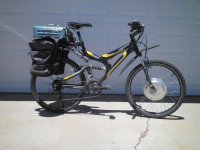dogman said:
Under 10 pounds of battery on the bars is dreamy. Any more and you will notice a slower swing time when you need to steer quick.
The motorcycle analogy is apt, it does feel different, heavy but with a more refined, planted control. 8)
I've run 25lbs up front, so far. The key is to have it hard-mounted, not sloshing around, and tightly packaged to the axis of the forks rotation. Steering response is snappier than a rear mounted battery because I am moving most if the mass of the bike with the handlebars, instead of translating that input through a flexing frame to a mass bouncing about in rear panniers.
After all, steering isn't a matter of how fast you can rotate the handlebars, it is how fast you change the mass's direction of travel. I can turn the handlebars very fast on my rear X5/30lb rear battery xtracycle, but I'd fall because the rear won't follow. With a front mount, I feel like the mass that needs to be turned is centered between my hands - because it is. The front wheel is always loaded for superior traction, and the battery gets the softest possible ride because it is directly connected to the stanchions.
I had a bad fall a few years back, swerving around a group of pedestrians (on the bike path, in my lane, backs to me

). I had a new build with a rear x5 and a @30lb rear pack. I swerved left fine, but when I tried to roll to the right, the underloaded front wheel lifted while I was looking right at it, and I dropped. I had done the same move on TF bikes hundreds of times, so I was surprised. I had a long time to think about it while my ribs healed and reasoned out that the problem was too much rear mass. I started working on a center battery, frustrated by the lack of room, then I saw a 50's show with a kid delivering bags of groceries in a front basket, and it got me thinking it was a great way to preload the front wheel and suspension.
When I look back at all the front-basket delivery bikes designs we've had over the last 100 years, it seems like heavy masses have frequently carried up front.
-JD



